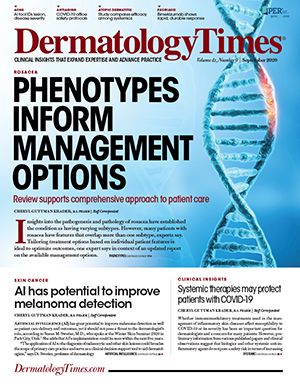- Case-Based Roundtable
- General Dermatology
- Eczema
- Chronic Hand Eczema
- Alopecia
- Aesthetics
- Vitiligo
- COVID-19
- Actinic Keratosis
- Precision Medicine and Biologics
- Rare Disease
- Wound Care
- Rosacea
- Psoriasis
- Psoriatic Arthritis
- Atopic Dermatitis
- Melasma
- NP and PA
- Skin Cancer
- Hidradenitis Suppurativa
- Drug Watch
- Pigmentary Disorders
- Acne
- Pediatric Dermatology
- Practice Management
- Prurigo Nodularis
- Buy-and-Bill
Publication
Article
Dermatology Times
Smartphones aid GEA scale assessment in patients with darker skin
Author(s):
Smartphones may provide another tool for physicians to assess acne severity in patients with darker skin types, a study shows.
Smartphones can be used to assess acne severity using the Global Evaluation Acne (GEA) scale in darker Fitzpatrick skin types, according to a poster presented during the AAD VMX Virtual Meeting Experience 2020 July 12-14.1
Acne is a very common polymorphic skin condition that can be characterized by a mosaic of signs and symptoms including comedones, papules, pustules, and nodules, which can in some cases lead to scarring. There are a number of different measures and techniques currently employed to grade the severity of acne such as simple grading techniques based on clinical examination, and lesion counting, as well as various types of photography, video microscopy, and measurement of sebum production. The GEA scale has been validated2 on photographs of acne patients and has been found to be very useful in helping clinicians to grade acne severity in their patients.
“Acne affects more than 85% of adolescents and often continues into adulthood regardless of skin color. The GEA scale largely used particularly by European health practitioners but has only been validated for face-to-face and photo evaluations for Caucasian people,” says Sophie Seité, Ph.D., La Roche-Posay Dermatological Laboratories, Levallois-Perret, France, co-author of the study.
RELATED: Algorithm effectively evaluates acne severity
Dr. Seité and colleagues conducted a study to assess the suitability of the GEA scale for acne severity diagnosis on smartphone images for Black African and Asian (Chinese) ethnicities compared to Caucasians. Images from the face including right and left profiles of 1,008 acne patients (571 Caucasian, 294 Black African, and 143 Chinese) were collected in France (35 percent), South Africa (50 percent), and China (15 percent). Participants had different acne severity grades and images were taken with two smartphones equipped with IOS or Android systems where possible. Using the GEA scale, three trained dermatologists then graded each patient’s acne severity from the three images taken with both IOS and Android systems. Inter and intra-rater reproducibility was assessed using Krippendorff’s alpha and Cohen’s kappa statistical tests.
There was a substantial intra-rater reproducibility for all ethnicities and all dermatologists, the authors note. Data showed the best agreement among the three evaluators was obtained for Black African participants for IOS images and the lower agreement for Chinese participants on Android images. According to Dr. Seité, the latter outcome may be associated with the lower number of Asian participants included in the study. Researchers also found that even if both IOS and Android systems have the same camera quality, the color rendition appeared to have an influence on acne severity assessment.
Compared with the Caucasian population, acne patients of Black African and, to a lesser degree, Asian (Chinese) origins may have issues with post-inflammatory hyperpigmentation (PIHP) as well as keloid formation. According to Dr. Seité, irregular patient follow‐up, as well as poor treatment outcomes associated with a positive correlation between the duration of the disease prior to treatment and the development of scars and post-inflammatory hyperpigmentation are the main challenges for clinicians and their patients.
“It is sometimes difficult to quantify inflammatory and comedonal lesions as well as post-inflammatory hyperpigmentation in non-Caucasian patients. As such, this technology can be useful for those health practitioners with a low number of consultations with non-Caucasian patients for the evaluation of acne severity, which could assist them in choosing the best therapeutic option for their patients,” Dr. Seité said.
According to Dr. Seité, health agencies recommend both the inflammatory and non‐inflammatory acne lesion count, so a computational method, including the automatic counting of lesions, may help in regard to the short time of the consultation.
“This is a useful approach to help dermatologists and especially other healthcare practitioners in providing the best care and early management of acne patients regardless of skin color. Nevertheless,post-inflammatory hyperpigmentation evaluation is key in non-Caucasian acne patients and for dermatologists with few consultations with patients of skin color, this tool can help them make easier and quicker assessments of acne severity,” Dr. Seité says.
Disclosure:
Dr. Seite, D Moyal, and G. Le Dantec are employees of La Roche-Posay, France.
References:
1 Seite S, Moyal D, Abidi K, Le Dantec G, Khammari A, Dreno B. Interest in Global Evaluation Acne (GEA) Scale on Facial Photographs for Different Ethnicities – AAD poster, Denver 2020
2Dreno B, Poli F, Pawin H, Beylot C, et al. Development and Evaluation of a Global Acne Severity Scale (GEA Scale) Suitable for France and Europe. J Eur Acad Dermatol Venereol. 2011 Jan;25(1):43-8. doi: 10.1111/j.1468-3083.3010.03685.x.






